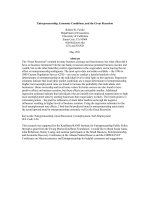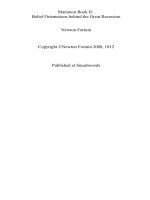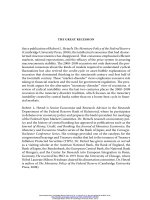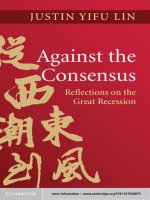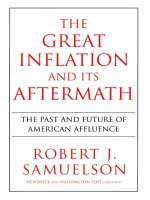Final projecthow did the great recession (2008) affect americas gdp
Bạn đang xem bản rút gọn của tài liệu. Xem và tải ngay bản đầy đủ của tài liệu tại đây (3.48 MB, 21 trang )
<span class="text_page_counter">Trang 1</span><div class="page_container" data-page="1">
<b>UNIVERSITY OF ECONOMICS AND LAW</b>
</div><span class="text_page_counter">Trang 2</span><div class="page_container" data-page="2">Table of Contents
<b>SECTION I: INTRODUCTION...2</b>
1.1. Definition and impact of the Great Recesstion on global economy...2
1.2. Thesis statement outlining how the Great Recession affected America's GDP...2
<b>SECTION II: BACKGROUND INFORMATION - OVERVIEW OF THE GREAT RECESSION IN THE U.S...3</b>
<b>SECTION III: TERMINOLOGIES AND CALCULATIONS...5</b>
3.1. Terminologies regarding calculating the US GDP...5
3.2. America's GDP data before and after the Great recession...6
a. US’s economics before and after the Great Recession...6
b. GDP calculation...9
<b>SECTION IV: RESULTS AND EFFECTS ON GDP...10</b>
4.1. Analysis of how the Great Recession affected America's GDP...10
4.2. Discussion of the decline in GDP growth rates and the rise in unemployment during the Great Recession...12
<b>SECTION V: POLICY RESPONSES AND COUNTERMEASURES...14</b>
<b>SECTION VI: CONCLUSION...15</b>
<b>SECTION VII: PROGRESS RECORD EVALUATIONS...16</b>
<b>REFERENCES...16</b>
</div><span class="text_page_counter">Trang 3</span><div class="page_container" data-page="3"><i>[ How did the Great Recession (2008) affect America’s GDP? ]</i>
<b>1.1. Definition and impact of the Great Recesstion on global economy</b>
The Great Recession is a term used to describe the economic crisis that began in 2008 and lasted until 2009. This recession was characterized by a severe and widespread decline in economic activity, a sharp rise in unemployment rates, and a significant drop in stock prices. The impact of the Great Recession was felt around the world and was one of the most severe economic downturns in modern history.
The first major impact of the Great Recession was a contraction in the global economy. Many countries experienced negative growth rates, and the world GDP fell by around 0.1% in 2009, marking the first contraction since World War II. The recession was particularly severe in developed countries, including the United States and Europe. The recession also resulted in widespread job losses, with many people losing their jobs or being forced to work reduced hours. The unemployment rate increased in many countries, and it took several years for employment levels to recover.
The recession was caused in part by a financial crisis, and it led to significant disruption in financial markets. Many banks and financial institutions failed, and there was a credit crunch, with businesses and individuals finding it difficult to access credit.
Lastly, the recession affect the government and economic policies all round the world. Governments around the world took steps to address the recession, including implementing fiscal stimulus programs, cutting interest rates, and providing support to banks and other financial institutions. Meanwhile, the recession also led to a rethinking of economic policy in many countries. There was a renewed focus on regulation of the financial sector, and there were debates about the appropriate role of government in the economy.
<b>1.2. Thesis statement outlining how the Great Recession affected America's GDP</b>
One of the countries that has their GDP significantly affected was the America. During the recession, GDP fell sharply, and it took several years for the economy to fully recover. The recession officially began in December 2007 and lasted until June 2009. During this time, the economy shrank for several consecutive quarters, and GDP fell by 4.3% from its peak in the fourth quarter of 2007 to its trough in the second quarter of 2009 (Robert Rich, 2013). This decline in GDP was the largest since the Great Depression of the 1930s.
The impact of the recession on GDP was felt across many sectors of the economy. For example, the housing market, which had been a major driver of economic growth in the years
</div><span class="text_page_counter">Trang 4</span><div class="page_container" data-page="4">construction activity, which in turn led to job losses in the construction industry and related sectors. The financial sector was also hit hard by the recession. Banks that had invested heavily in the subprime mortgages that fueled the housing market bubble saw their assets decline in value, leading to a credit crunch. This made it difficult for businesses to obtain the financing they needed to operate, which led to a significant decrease in economic activity.
The impact of the recession on GDP was felt for several years after the recession officially ended. Base on data.worldbank.org, in 2010, GDP grew by just 2.5%, which was below the long-term trend growth rate of around 3%. In 2011, GDP growth was even lower, at just 1.6%. It wasn't until 2014 that GDP finally surpassed its pre-recession peak, signaling the end of the economic recovery.
<b>SECTION II: BACKGROUND INFORMATION - OVERVIEW OF THE GREAT RECESSION INTHE U.S</b>
According to the National Bureau of Economic Research (the official arbiter of U.S. recessions), the Great Recession began in December 2007 and ended in June 2009, and therefore lasted more than 18 months.
After the Dot-com bubble burst in 2001 and the recession loomed large following the terrorist attacks of September 11, the US Federal Reserve System (Fed) took the monetary policy to save the economy from recession that is lowering the interbank overnight lending interest rate. In just a short time from January 2001 to December 2002, the interbank interest rate decreased 11 times from 6% to 1.75%. Secondary credit also reduces interest rates, stimulating the development of the real estate sector. In an easy credit environment, commercial and investment banks have eased home loans for less reliable borrowers, called sub-prime mortgages. As a consequence, anyone can get a home loan, even if they are less able and even unable to repay the loan.
</div><span class="text_page_counter">Trang 5</span><div class="page_container" data-page="5"><i>[ How did the Great Recession (2008) affect America’s GDP? ]</i>
* Federal Funds Effective Rate in the U.S. from 2001 to 2002
Low- interest rates caused many people to rush to buy houses, blowing up the real estate "bubble". Rising house prices made banks feel safe to give money to those who could not pay their loans because banks assumed that, if borrowers defaulted, they would foreclose on their homes for their value. pushed higher. According to the data, home prices in the US peaked by mid-2007 and began to decline. After the real estate bubble burst, the FED announced to start reducing interest rates from September 2007 to October 2008 (from 4.96% to 2%). Faced with tight lending conditions, banks suddenly find themselves owning homes whose value is not enough to cover the value of the loans. At the same time, not only do individuals have difficulty in repaying their loans, but many credit institutions that lend to buy houses are also in a similar situation because they cannot recover their debts.
</div><span class="text_page_counter">Trang 6</span><div class="page_container" data-page="6">* Home price in the U.S. from 2007 to 2008
* Federal Funds Effective Rate in the U.S. from September 2001 to October 2002 In addition, the rapid decline in housing prices has resulted in collateralized debt obligations (CDOs) and mortgage-backed securities (MBS) issued by financial institutions. The main issuer is severely discounted. U.S. mortgage-backed securities, which carry risks that are difficult to gauge, have been marketed around the world because they offer higher yields than U.S. government bonds. Many of these securities were backed by subprime mortgages, which fell in value when the U.S. housing bubble burst in 2006 and homeowners began defaulting on large numbers of payments. mortgages began in 2007. As a result, these institutions' balance sheets
</div><span class="text_page_counter">Trang 7</span><div class="page_container" data-page="7"><i>[ How did the Great Recession (2008) affect America’s GDP? ]</i>
housing credit crisis broke out.
The emergence of subprime lending losses in 2007 started the crisis and exposed other risky lending and overinflated asset prices. With loan losses increasing and the collapse of Lehman Brothers on September 15, 2008, a great panic broke out in the interbank lending market. The equivalent of a bank operating on top of the shadow banking system has resulted in many large and established commercial and investment banks in the United States and Europe such as Bear Steams, Dow Jones, Fannie Mae, and Freddie Mac suffering heavy losses and even went to the brink of bankruptcy. Typically, it also witnessed the heavy collapse of Washington Mutual (WaMu) with total assets loss of up to 307 billion dollars in this period.
Not only that, the Fed's pause in interest rate cuts (April 2008 - October 2008) made the global financial crisis worse.
<b>SECTION III: TERMINOLOGIES AND CALCULATIONS3.1. Terminologies regarding calculating the US GDP</b>
GDP stands for Gross Domestic Product and is a measure of the value of all goods and services produced within a country's borders during a given period of time, typically a year. There are three commonly used methods for calculating GDP: The Expenditure Approach: This method adds up all of the expenditures made within a country's borders during a given period of time. This includes personal consumption expenditures, investment expenditures, government spending, and net exports. The Income Approach: This method adds up all of the income earned by factors of production within a country's borders during a given period of time. This includes wages and salaries, profits, rents, and interest. The Production Approach: This method adds up the value of all goods and services produced within a country's borders during a given period of time, regardless of who produced it or where it was produced. This includes the value-added contribution of each firm in the production process.
To calculate private consumption, economists typically rely on data about household spending on goods and services. This includes everything from housing and food to transportation and healthcare. Investment, on the other hand, refers to spending by businesses on capital goods like machinery and equipment. Government spending includes everything from salaries for government employees to infrastructure projects like road construction. Finally, exports and imports are used to determine the net balance of trade between a country and its trading partners.
The calculation of GDP (Gross Domestic Product) is an important metric in the study of macroeconomics. It measures the total value of goods and services that a country produces
</div><span class="text_page_counter">Trang 8</span><div class="page_container" data-page="8">United States was fairly straightforward.
In general, GDP is calculated using the formula: GDP = C + I + G + (X-M), Where: C = private consumption
I = investment G = government spending X = exports
M = imports
To calculate private consumption, economists typically rely on data about household spending on goods and services. This includes everything from housing and food to transportation and healthcare. Investment, on the other hand, refers to spending by businesses on capital goods like machinery and equipment. Government spending includes everything from salaries for government employees to infrastructure projects like road construction. Finally, exports and imports are used to determine the net balance of trade between a country and its trading partners.
<b>3.2. America's GDP data before and after the Great recessiona. US’s economics before and after the Great Recession</b>
The Great Recession, which started in December 2007 and lasted until June 2009, significantly impacted the United States' gross domestic product (GDP). GDP is the total value of goods and services produced by a country in a given period, and it is a critical indicator of economic health. Before the Great Recession, the US economy was growing steadily, but the recession caused a sharp decline in GDP growth. Let's take a closer look at America's GDP data before and after the Great recession.
Before the Great Recession: The US economy had been growing at a steady pace before the Great Recession. According to the Bureau of Economic Analysis (BEA), the real GDP growth rate was 2.7% in 2006 and 2.0% in 2007. In fact, the US economy had experienced sustained economic growth since the recession of the early 2000s, with real GDP growing at an average annual rate of 2.3% from 2001 to 2007.During this period, the US was also experiencing high levels of employment and low inflation rates. To be precise, from 2005 to 2007, GDP increased by an average of 2.9% each year. However, in 2008, the economy began to slow down significantly, and GDP growth fell to just 0.4%. By 2009, the country was officially in a recession, and GDP had fallen by 2.8%. One of the key drivers of this decline was the collapse of the housing market. Prior to the recession, the housing market had been booming, with home prices rising rapidly and demand for new construction at an all-time high.
</div><span class="text_page_counter">Trang 9</span><div class="page_container" data-page="9"><i>[ How did the Great Recession (2008) affect America’s GDP? ]</i>
However, in 2007, the housing bubble burst, and home prices plummeted. This had a ripple effect throughout the economy, as homeowners suddenly found themselves underwater on their mortgages and banks began to fail. Another factor that contributed to the recession was the credit crunch. As the housing market collapsed, many banks and other financial institutions found themselves holding toxic assets and facing massive losses. This led to a freeze in lending activity, which in turn made it difficult for businesses and consumers to access credit. In response to these challenges, the federal government implemented a number of measures designed to stimulate the economy and prevent a full-blown depression. These measures included the American Recovery and Reinvestment Act, which allocated $787 billion in spending and tax cuts, and the Troubled Asset Relief Program, which provided up to $700 billion in support for the financial sector. These efforts did eventually have an impact, and by 2010, the US economy had begun to recover. GDP growth rose to 2.5% that year, and continued to increase in the years that followed.
By 2014, GDP growth had reached 2.9%. However, there were still significant challenges facing the US economy, and many of these challenges persisted in the years that followed the recession. For example, unemployment remained high, peaking at 10% in 2009 and remaining above 7% until 2013. Even after the unemployment rate began to decline, many workers were
</div><span class="text_page_counter">Trang 10</span><div class="page_container" data-page="10">Another challenge facing the US economy after the recession was income inequality. While GDP growth did eventually rebound, many Americans did not feel the benefits of that growth. Instead, the gains were concentrated among the wealthiest Americans, while many working-class families continued to struggle. This led to a growing sense of frustration and anger among many Americans, which helped fuel the rise of populist politicians like Donald Trump.
According to data from the Bureau of Economic Analysis, the nominal GDP of the United States in 2006 was $13.2 trillion, and in 2007, it was $14.0 trillion. This represented a growth rate of 5.7% between 2006 and 2007. In terms of the components of GDP, consumption and investment were the largest contributors to growth in these years. In 2006, personal consumption expenditures (C) accounted for 71% of GDP, while investment (I) accounted for 18%. Government spending (G) accounted for 19% of GDP, while net exports (X-M) represented a negative value, indicating that the United States was importing more than exporting. However, the Great Recession hit the United States hard, and GDP fell dramatically in 2008 and 2009. According to the Bureau of Economic Analysis, nominal GDP in 2008 was $14.3 trillion, but in 2009, it fell to $13.9 trillion. This represented a contraction of 2.8% between 2008 and 2009. The components of GDP also shifted during the Great Recession. Personal consumption expenditures (C) and investment (I) both fell, while government spending (G) increased. Net exports (X-M) also shifted from a negative value to a positive value, indicating that the United States was exporting more than importing. However, the United States was able to recover from the Great Recession, and GDP began to grow again in 2010. According to the Bureau of Economic Analysis, nominal GDP in 2010 was $14.8 trillion, representing a growth rate of 3.0% between 2009 and 2010. In 2011, nominal GDP grew to $15.5 trillion, representing a growth rate of 4.2%. Since the Great Recession, the United States has continued to experience growth in GDP. In 2019, nominal GDP reached $21.4 trillion, according to the Bureau of Economic Analysis. Consumption (C) and investment (I) continue to be the largest contributors to GDP, while government spending (G) and net exports (X-M) have remained relatively stable.
</div>